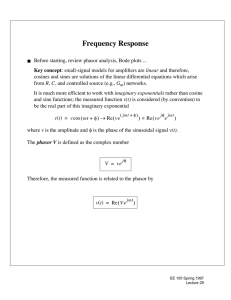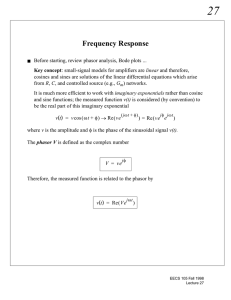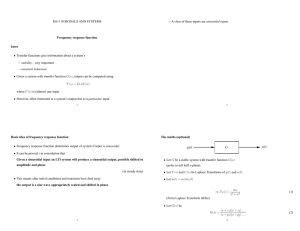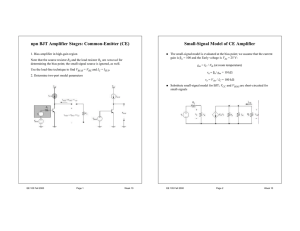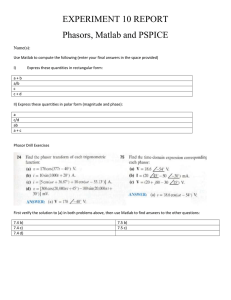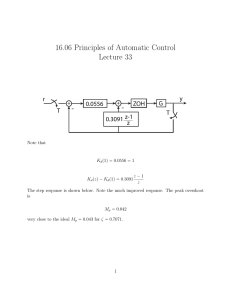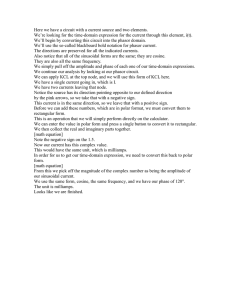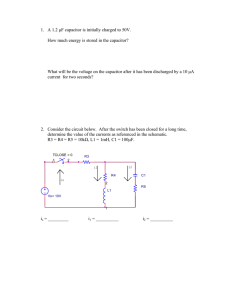Lecture 27
advertisement
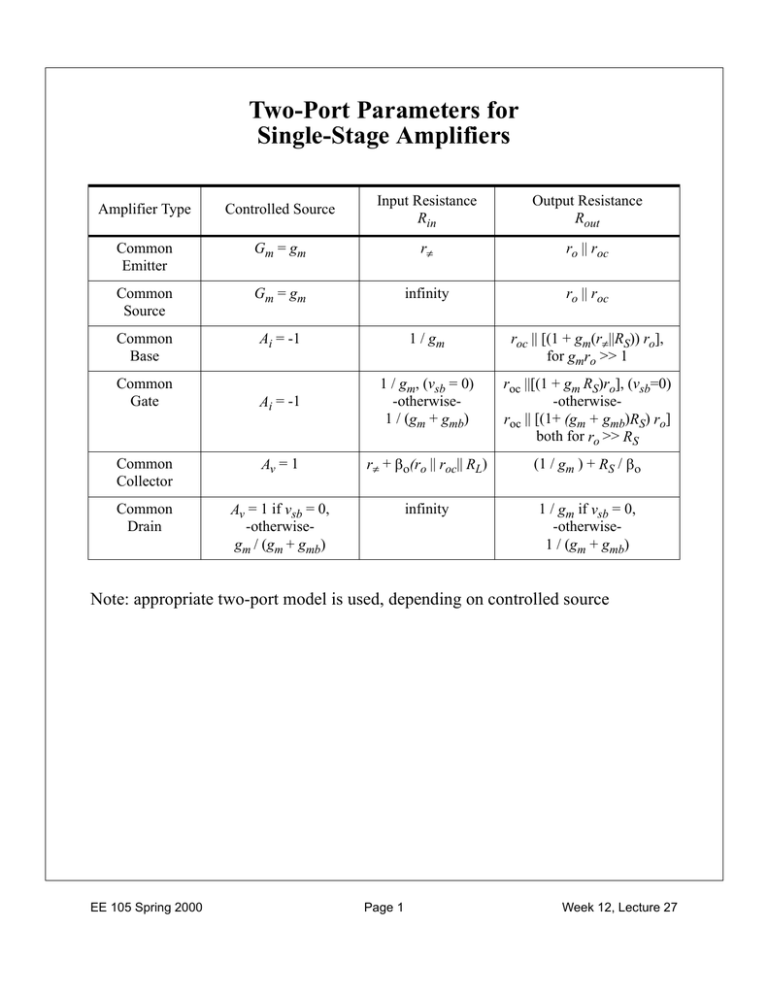
Two-Port Parameters for Single-Stage Amplifiers Amplifier Type Controlled Source Input Resistance Rin Output Resistance Rout Common Emitter Gm = gm rπ ro || roc Common Source Gm = gm infinity ro || roc Common Base Ai = -1 1 / gm roc || [(1 + gm(rπ||RS)) ro], for gmro >> 1 Ai = -1 1 / gm, (vsb = 0) -otherwise1 / (gm + gmb) roc ||[(1 + gm RS)ro], (vsb=0) -otherwiseroc || [(1+ (gm + gmb)RS) ro] both for ro >> RS Common Collector Av = 1 rπ + βο(ro || roc|| RL) (1 / gm ) + RS / βο Common Drain Av = 1 if vsb = 0, -otherwisegm / (gm + gmb) infinity 1 / gm if vsb = 0, -otherwise1 / (gm + gmb) Common Gate Note: appropriate two-port model is used, depending on controlled source EE 105 Spring 2000 Page 1 Week 12, Lecture 27 Sinusoidal Function Review Sinusoidal functions are important is analog signal processing v ( t ) = v cos ( ωt + φ ) amplitude (half of peak-to-peak) phase (degrees or radians) frequency (radian) ... ω = 2π f = 2π (1/T) v 1 ( t ) = v cos ( ωt ) v 2 ( t ) = v cos ( ωt – 45 ) 2π ω = -----T T 1. EECS 20/120: periodic functions can be represented as sums of sinusoids functions at different frequencies. 2. The response of a circuit to a sinusoidal input signal, as a function of the frequency, leads to insights into the behavior of the circuit. EE 105 Spring 2000 Page 2 Week 12, Lecture 27 Frequency Response Key concept: small-signal models for amplifiers are linear and therefore, cosines and sines are solutions of the linear differential equations which arise from R, C, and controlled source (e.g., Gm) networks. * The problem: finding the solutions to the differential equations is TEDIOUS and provides little insight into the behavior of the circuit! vout(t) vs(t) EE 105 Spring 2000 R C Page 3 Week 12, Lecture 27 Phasors It is much more efficient to work with imaginary exponentials as “representing” the sinusoidal voltages and currents ... since these functions are solutions of linear differential equations and jωt d jωt ----- ( e ) = jω ( e ) dt How to connect the exponential to the measured function v(t)? Conventionally, v(t) is the real part of the of the imaginary exponential v(t) = v cos ( ωt + φ ) → Re ( ve ( jωt + φ ) jφ jωt ) = Re ( ve e ) where v is the amplitude and φ is the phase of the sinusoidal signal v(t). The phasor V is defined as the complex number V = ve jφ Therefore, the measured function is related to the phasor by v(t) = Re ( Ve EE 105 Spring 2000 Page 4 jωt ) Week 12, Lecture 27 Circuit Analysis with Phasors * The current through a capacitor is proportional to the derivative of the voltage: i(t) = C d v(t) dt We assume that all signals in the circuit are represented by sinusoids. Substitution of the phasor expression for voltage leads to: v(t) → Ve jωt … Ie jωt jωt jωt d = C ( Ve ) = jωCVe dt which implies that the ratio of the phasor voltage to the phasor current through a capacitor (the impedance) is V 1 Z(jω) = --- = ---------I jωC * Implication: the phasor current is linearly proportional to the phasor voltage, making it possible to solve circuits involving capacitors and inductors as rapidly as resistive networks ... as long as all signals are sinusoidal. EE 105 Spring 2000 Page 5 Week 12, Lecture 27 Phasor Analysis of the Low-Pass Filter * Voltage divider with impedances -- Replacing the capacitor by its impedance, 1 / (jωC), we can solve for the ratio of the phasors Vout / Vin V out 1/jωC ----------- = -----------------------V in R + 1/jωC multiplying by jωC/jωC leads to V out 1 ---------- = ----------------------V in 1 + jωRC EE 105 Spring 2000 Page 6 Week 12, Lecture 27 Frequency Response of LPF Circuits The phasor ratio Vout / Vin is called the transfer function for the circuit How to describe Vout / Vin? complex number ... could plot Re(Vout / Vin) and Im(Vout / Vin) versus frequency polar form translates better into what we measure on the oscilloscope ... the magnitude (determines the amplitude) and the phase * “Bode plots”: magnitude and phase of the phasor ratio: Vout / Vin range of frequencies is very wide (DC to 1010 Hz, for some amplifiers) therefore, plot frequency axis on log scale range of magnitudes is also very wide: therefore, plot magnitude on log scale Convention: express the magnitude in decibels “dB” by V out V out = 20 log -------------------V in dB V in phase is usually expressed in degrees (rather than radians): Im ( V out ⁄ V in ) V out ---------= atan ----------------------------------∠ Re ( V out ⁄ V in ) V in EE 105 Spring 2000 Page 7 Week 12, Lecture 27 Complex Algrebra Review * Magnitudes: 2 2 X1 + Y1 Z1 Z1 ------ = --------- = ----------------------- , where Z2 2 2 Z2 X2 + Y2 Z 1 = X 1 + jY 1 Z2 = X2 + Y2 * Phases: Z1 Y Y ∠------ = ∠Z 1 – ∠Z 2 = atan -----1- – atan -----2Z2 X1 X2 * Examples: EE 105 Spring 2000 Page 8 Week 12, Lecture 27
